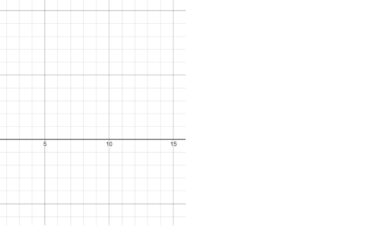Mathematics
Introduction: In the vast realm of mathematics, there exist several intriguing concepts that have fascinated mathematicians and scholars for centuries. One such concept is that of asymptotes. Asymptotes play a crucial role in understanding the behavior and limits of mathematical functions, particularly as they approach infinity. In this blog post, we will delve into the fascinating world of asymptotes, exploring their definition, types, and real-world applications.
Defining Asymptotes: An asymptote is a straight line or curve that a given function continually approaches but never touches or crosses. In other words, as the independent variable of a function approaches a certain value or infinity, the function approaches the asymptote without ever reaching it. Asymptotes are particularly relevant in analyzing the behavior of functions in their limits.
Types of Asymptotes: There are three main types of asymptotes: horizontal, vertical, and oblique (slant) asymptotes. Let’s explore each type in detail:
- Horizontal Asymptotes: A horizontal asymptote is a straight line that a function approaches as the input variable tends towards positive or negative infinity. For a function to have a horizontal asymptote, its values must either tend towards a specific constant or become infinitely large. The equation of a horizontal asymptote is usually written as y = c, where c represents the constant value approached.
- Vertical Asymptotes: Vertical asymptotes occur when a function approaches infinity or negative infinity as the input variable approaches a particular value. This value is typically a root of the function’s denominator. Vertical asymptotes indicate restrictions on the function’s domain and occur when the function approaches a singularity, leading to an undefined value.
- Oblique (Slant) Asymptotes: Oblique asymptotes are represented by slanted lines that a function approaches as the input variable moves towards positive or negative infinity. Unlike horizontal and vertical asymptotes, which are straight lines, oblique asymptotes are characterized by a linear equation in the form y = mx + b. These asymptotes occur when the degrees of the numerator and denominator of a rational function are unequal.
Real-World Applications: Asymptotes find numerous applications in various fields, including engineering, physics, and economics. Here are a few examples:
- Electrical Engineering: In circuit analysis, asymptotes are used to determine the behaviour of electrical signals, such as voltage or current, as they approach specific limits. Engineers utilize asymptotes to design and optimize circuit components.
- Economics: Asymptotes help economists understand economic models and analyse trends in data related to population growth, resource utilization, and market saturation. They aid in predicting long-term outcomes and making informed decisions based on mathematical models.
- Physics: Asymptotes play a crucial role in studying the behaviour of physical quantities, such as velocity, acceleration, or displacement, as they approach extreme values. They enable physicists to comprehend the limits of physical phenomena and analyse their implications.
Conclusion: Asymptotes are powerful tools in mathematics, offering insights into the behaviour of functions as they approach specific values or infinity. Horizontal, vertical, and oblique asymptotes provide valuable information about the limits and restrictions of mathematical functions. Understanding asymptotes not only enhances our grasp of mathematical concepts but also finds applications in various real-world scenarios. By exploring the intricacies of asymptotes, we unlock a deeper understanding of the fundamental nature of mathematical functions and their limitless potential
Points of inflection, Stationary points, and Critical points:
Unveiling Mathematical Turning Points: Inflection Points, Stationary Points, and Critical Points
Introduction: Within the realm of mathematics, certain points hold particular significance in understanding the behaviour of functions and curves. Inflection points, stationary points, and critical points are three such crucial points that play a fundamental role in calculus and optimization. In this blog post, we will explore the characteristics, differences, and applications of these key points, shedding light on their significance in mathematical analysis.
Inflection Points: An inflection point is a point on a curve where the concavity changes. In other words, it is a point at which the curve transitions from being concave upwards (opening upward like a “U”) to concave downwards (opening downward like an “n”) or vice versa. At an inflection point, the curve’s second derivative changes sign, indicating a change in curvature. Mathematically, an inflection point occurs when the second derivative of a function equals zero or is undefined.
Stationary Points: Stationary points, also known as critical points or turning points, are points on a curve where the derivative of a function is zero or undefined. They represent locations where the function’s rate of change momentarily comes to a halt. Stationary points can occur at local maxima (peaks) or local minima (valleys) of a function or at points where the function has a horizontal tangent line. To determine the nature of a stationary point (whether it is a maximum, minimum, or neither), further analysis using the first or second derivative test is often required.
Critical Points: Critical points are closely related to stationary points. They are the values of the independent variable (x-values) that make the derivative of a function zero or undefined. Critical points encompass both stationary points and points where the function’s derivative is undefined. By analysing critical points, we gain insight into where the function may exhibit significant changes in behaviour.
Applications: Inflection points, stationary points, and critical points find various applications across different fields. Here are a few examples:
- Optimization Problems: In optimization, finding critical points is crucial to identifying maximum or minimum values of functions. By analysing stationary points and their nature (whether they are maxima or minima), engineers and economists can optimize processes, design efficient systems, and maximize profits.
- Curve Sketching: Inflection points play a vital role in accurately sketching curves. Understanding the points where the curve changes its concavity allows us to capture the overall shape of the graph and predict its behaviour. This information helps mathematicians and scientists visualize and interpret data.
- Physics and Engineering: In physics, critical points help determine the position, velocity, and acceleration of objects in motion. Engineers utilize critical points to analyse the behaviour of structures, such as bridges or buildings, and ensure their stability and safety.
Conclusion: Inflection points, stationary points, and critical points are significant landmarks in the study of functions and curves. Inflection points mark the transition in concavity, while stationary points and critical points provide insights into the function’s behaviour and optimization potential. Understanding these points unlocks a deeper comprehension of the underlying mathematics and empowers us to solve complex problems in various fields. By appreciating the significance of these turning points, we embark on a journey to explore the intricacies and beauty of mathematical analysis.



Excellent coaching given by well experienced staff.
Medication information for patients. Effects of Drug Abuse.
Your comment is awaiting moderation.nolvadex without rx
Some what you want to know about medicament. Get information now.